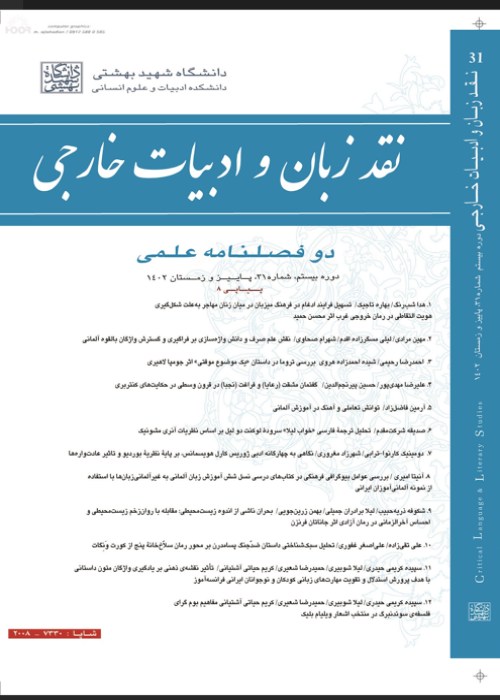Studying and comparing the level of literariness of the sixth chapter of Saadi's Golestan and its Russian translation based on the Busemann equation
One of the controversial issues in translating important Persian literary works into other languages is to examine the level of literariness of the translated text compared to the original text. In statistical stylistics, by examining the form and content of the works, it is possible to achieve the literary level of the texts. In this regard, Busemann, a German linguist, has introduced an equation to check the level of literariness of texts. In this equation, the value of VAR or verb-to-adjective ratio is calculated, and the larger the quotient is, the more literary the text is, and vice versa, if the quotient of dividing the number of verbs into adjectives is a small number, the text is closer to scientific style. In the present research, we first adapted Busemann's equation for use in Russian texts and studied the conditions of determining the verb and adjective in the Russian language, and then studied the stories of the sixth chapter of Saadi's Golestan and their translation into Russian by Starostin from the point of view of level of literariness. Our research showed that the level of literariness of the sixth chapter of Saadi's Golestan is more than its translation, but Starostin's translation is due to using the poetic translation, the translator's youth, and the use of rhyming words and verbal and semantic puns in the Russian language in translating rhyming prose of Golestan, is an acceptable translation and it can be said that the translator has succeeded in translating and transferring the literariness of Golestan into Russian.
One of the most accurate schools in the literary criticism is statistical stylistics. In statistical stylistics, quantitative and statistical analysis is used to find the style of the studied work. One of the methods of statistical stylistics that has recently been welcomed by researchers is the Busemann equation. Busemann, a German linguist, proposed it for the first time, and in 1925, after it was used in German texts, it was proposed and used in statistical stylistics studies of various texts. In the Busemann equation, the number of verbs and adjectives in the examined text is calculated, and the division of the number of verbs by the adjective indicates the literary style of the examined text. The greater number of verbs compared to adjectives makes the text more literary, and the excess of adjectives compared to verbs in the text reduces the literariness of the text and makes the style of the text closer to the scientific style.
Background Studies:
Most of the researches that have been written on the basis of Busemann's equation have used this equation in Arabic texts, which is because Saad Maslouh (1992), an Egyptian linguist, localized Busemann's equation in the Arabic language to be used in the analysis of Arabic texts, thus the way has been paved for researchers to study Arabic texts. This equation has not been used in the analysis of Russian works or translations from Persian to Russian. Below are some of the researches done on this subject:Omidvar et al. (2019) have investigated the literariness of the Hashemiat of Komit Asadi and Hijaziat of Sharif Razi based on Busemann's equation. Sedghi and Rustayi (2013) have examined examples of classical poetry, free and blank verses according to this equation. In a research based on Busemann's equation, Naimi and Torabi Hour (2018) have investigated the literariness of style of the poetry collection "Qalat li al-Samra" by Nizar Qabbani and "Rastakhiz" by Simin Behbahani. Shamsabadi et al. (2021) also rely on this equation analyzed the poetics of women's writing in a story by Haifa Bitar. In an article, Sedghi and Zare Bormi (2014) analyzed the style of Maqamat of Hamadani and Hariri, and Amiri and Parvin (2015) used Busemann's equation to analyze the style of Nahj al-Balagha sermons.Methodology and Argument: In this research, the level of literariness of the sixth chapter of Saadi's Golestan and the translation of this chapter by Aliev and Starostin have been investigated. The questions that we are trying to find answers to in this article, which was written with a descriptive-analytical method, are: According to the criteria of the Busemann's equation, is the text of Golestan more literary or the text of its translation? What factors have influenced the literariness of both works? The hypothesis of the research is that because the poems of Golestan Saadi were translated by Aliev and Starostin into Russian poetry and because of this fact that these two translators were younger than Saadi, and Aliev and Starostin resorted to the solution of compensating for the loss of meaning in translating of the verbal and semantic puns of Golestan, the literariness of the translation of the sixth chapter of Golestan is lower than the original text, but it is acceptable.
In this research, the level of literariness of the sixth chapter of Saadi's Golestan and its translation by Aliev and Starostin was investigated based on the criteria of the Busemann's equation and the calculation of the verb-to-adjective ratio, and it was shown that although the literariness of the original text is higher than its translation, but some factors, like that translators are younger than Saadi Shirazi, and benefiting from the poetic translation and the use of rhyming words and verbal and semantic puns in the Russian language when translated rhyming prose of Golestan have made the translation acceptable and it can be said that The translators have succeeded in translating and transferring the literariness of Golestan into Russian language.
- حق عضویت دریافتی صرف حمایت از نشریات عضو و نگهداری، تکمیل و توسعه مگیران میشود.
- پرداخت حق اشتراک و دانلود مقالات اجازه بازنشر آن در سایر رسانههای چاپی و دیجیتال را به کاربر نمیدهد.


